Reaction I : CH3CH2−CH−CH3+N(CH3)3OH−heat−−→ Product
Reaction II : CH3CH2−C∣BrH−CH3CH3ONa−−−−−→ Product
Products are CH3−CH=CH−CH3(X)
CH3CH2CH=CH2(Y) Solution in Telugu
The major product in reaction 1 is (X)
The major product in reaction 1 is (Y)
The major product in reaction 2 is (X)
The major product in reaction 2 is (Y)
The correct Answer is:B, C
Rean .1. follows Hoffmann.s elimination , Rean .2. follows Saytsoff.s rule
Topper's Solved these Questions
- BOOK - AAKASH SERIESCHAPTER - AMINES AND AZO COMPOUNDS EXERCISE - LEVEL - II (LECTURE SHEET) EXERCISE-II54videos
AMINES AND AZO COMPOUNDS
- BOOK - AAKASH SERIESCHAPTER - AMINES AND AZO COMPOUNDS EXERCISE - LEVEL - II (LECTURE SHEET) EXERCISE-III (Linked Comprehension type questions) Passage - I :3videos
AMINES AND AZO COMPOUNDS
- BOOK - AAKASH SERIESCHAPTER - AMINES AND AZO COMPOUNDS EXERCISE - LEVEL - II (LECTURE SHEET) EXERCISE - I (Cyanides and Isocynaides)1videos
AMINES AND AZO COMPOUNDS
- BOOK - AAKASH SERIESCHAPTER - ALKYL AND ARYL HALIDESEXERCISE - OBJECTIVE EXERCISE - 4 (ASSERTION (A) & REASON (R) TYPE QUESTIONS)19videos
ALKYL AND ARYL HALIDES
- BOOK - AAKASH SERIESCHAPTER - AMINES AND DIAZONIUM SLATSEXERCISE - PRACTICE EXERCISE25videos
AMINES AND DIAZONIUM SLATS
Similar Questions
Gabriel-Phthalimide reaction is useful for preparation of
05:04View SolutionThe reaction of amines with NaNO2+HCl depends on the type of the amine and whether it is aliphatic or aromatic. The diazo group developed in aliphatic primary amines is rather highly unstable and decompose to produce mainly alcohols. Secondary amines react to give yellow oily liquids.
Which of the following amines give yellow oily liquid nitroso compounds on reaction with NaNO2+HCI.04:23View Solution
CH3MgBr−−−−−→AH3O+−−−→B. The compound ‘B' is02:07View Solution(A) Towards SN2 reaction, order of reactivity is CH3Br>CH3CH2Br>(CH3)2CHBr>(CH3)3CBr.
(R) Greater the stability of carbocation, greater will be its ease of formation from alkyl halide and faster will be the rate of SN1 reaction.View SolutionIUPAC name of (C2H5)3C−NH2 is
View SolutionWrite IUPAC name of the following compound (a) CH_(3)-CH_(2)-underset(CH_(3))underset(|)(CH)-CH_(2)underset(CH_(2)-CH_(3))underset(|)(CH)-CH_(2)-CH_(2)-CH_(3) (b) CH_(3)-underset(CH_(3))underset(|)overset(CH_(3))overset(|)(C)-CH_(2)-overset(CH_(2)-CH_(3))overset(|)(CH)-CH_(2)-underset(CH_(3))underset(|)(CH)-CH_(3) (c)
02:25View SolutionWrite the IUPAc name of the following compound :
(a) CH3−CH2−CH3∣CH−CH=CH−CH2−CH3
(b) CH3−CH2−CH3∣CH−CH2−CH3∣CH−CH∣CH2∣CH2∣CH−CH3∣CH3−CH=CH3∣C−CH304:16View SolutionCH_(3)-underset(CH_(3))underset(|)(CH)-CH=CH-CH_(2)-overset(O)overset(||)(C)-OH
View SolutionGive the IUPAC names of the following compounds:
(i)C6H5−CH2−CH2−OH (ii)CH3−CH3∣C∣CH3−CH2−CH2−OH
(iii)[(CH3)2CH]3COH. (iv)CH3−CH∣OH−CH2−CH2−O−CH2CH3
(v)CH3−CH2−CH∣Cl−CH∣CH3−CH3∣C∣OH−CH3 (vi)
(vii)(CH3)3COH (viii)CH3−CH∣CH3−CH∣OH−CH2−CH∣CH3−CH3
(ix) CH2OH |CH2−CH2−CH−CH−CH−CH3 | | CH2Cl CH3, (x) CH3−C=C−CH2OH | | CH3Br
(xi) CH2=CH−CH∣OH−CH2−CH3, (xii) CH2OH |CH3−CH−CH2−CH−CH−CH3 | | CH3 OHView SolutionThe IUPAC name of the compound CH_(3)CH_(2)CH_(2)underset(CH(CH_(3))_(2))underset(|)(CH)-overset(CH_(3))overset(|)(CH)-underset(CH_(2)CH_(3))underset(|)overset(CH_(2)CH_(3))overset(|)(C)-CH_(2)CH_(3)
02:28View SolutionName the CH_(3)-CH_(2)-underset(CH_(2)Cl)underset(|)CH-overset(CH_(2)OH)overset(|)CH-underset(CH_(3))underset(|)CH-CH_(3) compound according to IUPAC system.
05:16View SolutionCH3−CH2−CH∣CH2Cl−CH2OH∣CH−CH∣CH3−CH3 यौगिक के नाम IUPAC पध्दतिनुसार कीजिये-
View SolutionProduct of the following reaction is - [ CH_(3) - underset(CH_(3))underset(|)overset(CH_(3))overset(|)(N) -underset(CH_(3))underset(|)(CH) - CH_(2) - CH_(3)]^(+) OH^(-) overset(Delta)to
View SolutionCH_(3)-CH= CH-CH_(3)+ Br_(2) to CH_(3)-underset(Br)underset(|)CH-underset(Br)underset(|)CH-CH_(3) is an
03:28View SolutionName the following compounds according to IUPAC system. (i) CH_(3) - CH_(2) - underset (CH_(2)Cl) underset(|)(CH) - overset (CH_(2)OH) overset(|) (CH) - underset (CH_(3)) underset (|) (CH) - CH_(3) CH_(3)- underset (CH_(3)) underset(|) (CH) -CH_(2) - underset(OH) underset(|) (CH) - overset (CH_(2)OH) overset(|) (CH) - CH_(2) (iii) (iv) H_(2)C = CH - underset (OH)underset (|) (CH) - CH_(2) - CH_(2) - CH_(3) (v) CH_(3) - underset (CH_(3)) underset ( |) C = underset (Br)underset(|) C - CH_(2)OH
02:41View Solution

